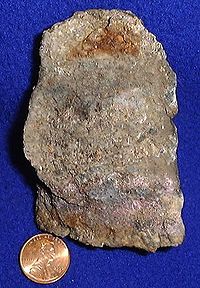
Photo from wikipedia
In this study, a hydrometallurgical method for the recovery of copper, cobalt, and zinc from copper slag flotation tailings (SFT) was investigated. SFT contains large amounts of valuable metallic compounds,… Click to show full abstract
In this study, a hydrometallurgical method for the recovery of copper, cobalt, and zinc from copper slag flotation tailings (SFT) was investigated. SFT contains large amounts of valuable metallic compounds, such as copper, cobalt, and zinc. A representative SFT sample containing 0.50% Cu, 0.148% Co, 3.93% Zn, and 39.50% Fe was used in experimental studies. High-pressure oxidative acid leaching of SFT was carried out to assess the effects of sulfuric acid concentration, oxygen partial pressure, reaction time, solid/liquid ratio, and temperature on the extraction of copper, cobalt, zinc, and iron. The dissolution of metals from the SFT sample increased with temperature and sulfuric acid concentration. However, high acid concentrations and high solid/liquid (S/L) ratios led to gel formation that caused filtration problems and inhibited metal dissolution. The optimum leaching conditions were found to be a leaching time of 90 min, an acid concentration of 250 kg/t, a temperature of 220 °C, an S/L ratio of 1:5, and an oxygen partial pressure of 0.7 MPa. Under these conditions, 93.1 ± 1.1% Cu, 96.3 ± 1.8% Co, and 92.3 ± 1.7% Zn were extracted. Iron dissolution was only 0.5 ± 0.1%. This hydrometallurgical process almost completely recovers valuable metals. In particular, cobalt, which is of great importance in the production of lithium-ion batteries, has been declared a critical metal by the United States, Canada, and the EU and was taken into solution with very high extraction efficiency (>95%). Additionally, oxygen partial pressure enhanced copper, cobalt, and zinc dissolution. When O2 was not introduced into the leaching system, the extraction efficiencies of Co, Cu, and Zn were approximately 24.5, 5.3, and 26.3%, respectively, after 2 h of leaching treatment.
Journal Title: ACS Omega
Year Published: 2022
Link to full text (if available)
Share on Social Media: Sign Up to like & get
recommendations!